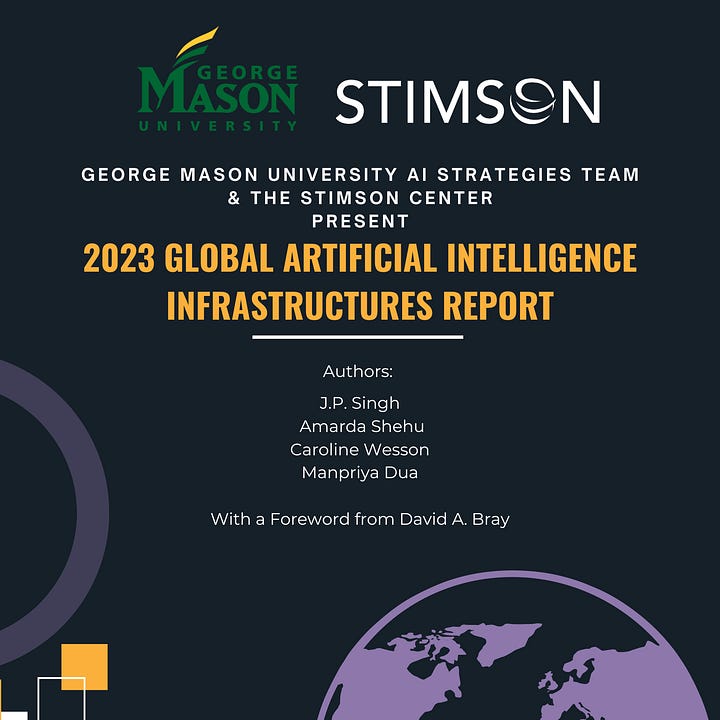GMU AI Strategies' 2023 Global AI Infrastructures Report Release
AI Infrastructures and Their Consequences in Global Contexts
This project looks at how cultural values and institutional priorities shape artificial intelligence infrastructures in both national and global contexts, in order to better understand the effects of comparative AI contexts for security. Learn more at our website.
The GMU AI Strategies team presents our 2023 Global AI Infrastructures Report
Our team is pleased to announce the release of our first policy report, the “2023 Global AI Infrastructures Report”. This report employs computer science techniques to analyze national and sub-national AI policies published by 54 different countries. At its publication it is the most comprehensive analysis to date on national AI policies. The report analyzes the empirical determinants of dominant strategies for developing AI around the globe and shows where countries are converging and diverging in their approaches to AI. The cross-national and global comparisons are important for a host of important players in AI including policy-makers, governments, businesses, and civil society organizations.
Stimson Center’s David Bray wrote the Foreword to the report calling it “prescient” and notes that the “report presents both rigorous and much needed insights that demystify some of the current fervor around the future AI and societies.”
To download the report please visit our website.


In 2016, the United States published its National Artificial Intelligence Research and Development Strategic Plan, usually understood in policy communities as the first statement of its AI infrastructure strategy (Select Committee on Artificial Intelligence, 2016). Since then over 60 countries have announced their national or sectoral AI policies.
This report employs computer science techniques, specifically Latent Dirichlet Analysis (LDA), to analyze the published national AI plans of 54 countries. In other words, we employ AI to analyze AI strategies. The report includes an analysis of 213 documents on AI strategies. Apart from national plans, the set includes reports and publications from various government departments, ministries, nation commissions, bodies appointed to forward recommendations for specific issues and sectors.
Some of the key takeaways from this report include:
There is no grand strategy or conclusion that applies to all AI infrastructures. Countries and clusters of countries feature different objectives and how to achieve them.
Countries are pursuing a variable mix of similar elements in their national strategies. We propose and utilize the concept of ‘AI Wardrobes’ to show the various elements available for putting together an AI infrastructure and the variable ways in which countries are putting together these wardrobes.
Clusters of countries pursuing similar strategies are identifiable. Our machine learning algorithms are able to point out some obvious clusters from the European Union, Latin America, and East Asia. But there are also surprises. United Kingdom leads a British influence cluster. Spain is prominent in the Latin American cluster.
In addition to these broader take-aways, for this report our team has developed three policy recommendations:
Comparative analyses like ours provide countries sign posts and guidelines for their ambitions. There is no one size fits all for designing national AI infrastructures. Different countries have different capabilities and priorities.
Regulating AI will depend on country preparedness and political systems. Grand pronouncements such as fears about sacrificing our human rights or privacy to machine-led systems in our media about AI need a reality check. Several countries, generally with democratic systems, are putting together or struggling to put together systems of accountability, while others barely feature any such concerns. This provides room to think about governance issues, rather than ceding this authority to machines (or corporations) prematurely.
AI policies have many good stories to tell about service provision. These include AI applications for health, education and research, and transportation.
Ultimately, this report illustrates that there are convergences and divergences in the values and goals for national AI infrastructures around the world. The research illustrates that there is a set of policy mechanisms which are commonly used in AI infrastructures and that countries choose their own combinations of these mechanisms to best fit their needs.
Venture capitalist Stephen Ibaraki and founder of UN’s AI for Good Summit notes that the report is “a pivotal contribution to understanding the evolution and nuances of AI strategies and a comprehensive and in-depth exploration of AI infrastructures on a global scale. Its meticulous structure, blending both qualitative narratives and empirical findings, offers an unparalleled and comprehensive lens through which we can discern the trajectory of dynamic AI developments across nations.”
To learn more about and download the 2023 Global AI Infrastructures Report please visit our website: https://www.aistrategies.gmu.edu/report. For questions and inquiries please contact us at: aipolicy@gmu.edu.



